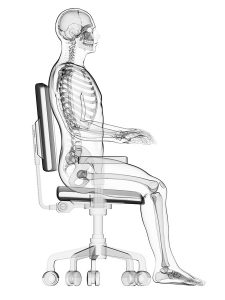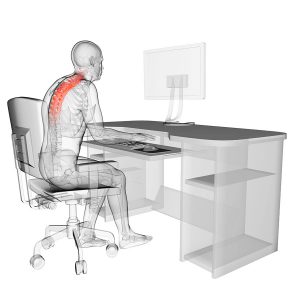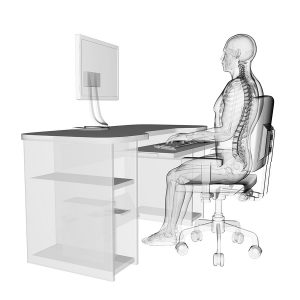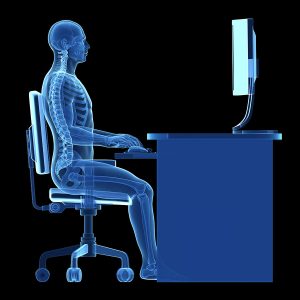Do you think you have bad posture? You are probably right! But so does most of us. We live our lives hunched over screens, steering wheels, workstations, the stove, or caring for children. That’s not so much different from the positions our ancestors were in 100 years ago. They were hunched over newspapers, hand washing, gardening, manual labor or caring for children. The difference is they didn’t spend their off time lounging on couches or beds with more screens. They were physically more active and fit than we are now. Proper posture is a habit that you can develop with posture correction exercises. Improve your posture with correct sitting postural habits when you do have to work for extended periods of time.
Is it as simple as sitting up straight?
Posture is a complex interplay of your skeletal hard frame and muscle strength and endurance. Poor posture will rarely be the only reason you are suffering from your symptoms. It contributes to your unique situation. Our physiotherapists have the knowledge and skill to determine what is causing your symptoms and address the issues effectively.
Efficient static and dynamic posture (see below) amplifies your capacity to change, making you more resilient and adaptable to the demands of your working day and exercise habits. This means that the one day the lift was broken or the meeting ran over your body had the capacity to adapt to climbing the stairs or sit for longer.
Why would you want to improve your posture?
Would you drive around in your car without having your wheel alignment checked? I hope not. Just like unbalanced wheel alignment leads to uneven wear of your car’s tyres, the same is true for your body. Excessive, skewed load transfer on your joints can increase your risk of osteoarthritis of that joint in the long run. Or any overuse injury when you increase your training load, like patellar tendonitis or rotator cuff tendonitis.
Effects of Proper Posture
Optimal joint loading will:
- Ease pain
- Reduce inflammation
- Decrease muscle spasm
- Stimulate muscle contraction
Optimal breathing will:
- Increase oxygenation
- Increase cellular metabolism
- Improve blood supply to injured tissue
- Increase cell regeneration
- Improve digestion
- Decrease anxiety
- Improve immune function
“Proper posture = increased resilience”

What exactly is correct sitting posture?
Does perfect posture exist? No. Our bodies are designed to move. We don’t share any structural similarities with a building. We are meant to move. Proper posture and good postural habits are meant to be a reference to return back to throughout your moving day, not a rigid position to maintain.
Proper posture means you align your major joints one over the other to lessen the load and structural strain on your joints. Want to try that while sitting?
- Balance evenly on your sitting bones
- Elongate the crown of your head to the ceiling
- Open your collarbones forward
- Balance your earlobes over your shoulders
Done! Easy enough. You will at some point move a little closer to the screen. The trick is to remind yourself to return to proper posture frequently throughout your day.
Different types of posture
We can differentiate between static and dynamic posture. Static posture is the position you are in behind your desk or in your car, where there is no movement or very little movement involved. This is where you want to use the laws of physics to your advantage by stacking your major joints one over the other. Even though there is little movement involved you still need a fair amount of static stability from your core muscles. You will still need to take movement breaks throughout your working day.
Dynamic posture is the position you transition from, more commonly referred to as your exercise form. Here we use the laws of physics, muscle endurance that you need for static posture, plus muscle strength when you start to add weights, inclines, and resistance to your training. A personal trainer, exercise partner, mirror or video can be great to check your form while training.
Posture correction strategies
Physiotherapists use posture correction exercises, in conjunction with other treatment techniques, to help you establish optimal movement patterns. Muscles work over joints like a pulley system. If one member of the team isn’t doing their job the others will have to take up the slack. This may lead to overuse and compensation patterns.
Posture correction exercises will form part of your rehabilitation program. Everybody’s case is unique, you may need 5 exercises while your neighbor needs 10. Your physiotherapist is qualified to determine which muscles need to be strengthened to help you move better. We aim to pick exercises that challenge you while building endurance. This will be different from person to person. You can expect your home exercise program to include exercises with resistance bands or weights, range of motion exercises, stretches and maybe some breathing exercises too.
We will include manual treatment if needed, like joint mobilisations, nerve glides, myofascial release, deep dry needling or electrotherapy as needed by your unique situation and symptom severity.
Braces or strapping will be used for short term symptom relief. We use these modalities in the same way you use a crutch or shoulder sling. Its purpose is to supply support and protection for a short period of time while the tissue heals and inflammation settles. Prolonged use of braces or strapping risks long term dependence.
Anatomical implications of poor posture
Bad posture can lead to undesirable aesthetics and increase your risk of developing structural change due to continuous nonoptimal biomechanical movement. To be honest a slouching forward posture makes you look defeated, shy, uncertain, or troubled, which doesn’t instill confidence in your colleagues, teachers, or potential clients. If you stand up tall on the other hand you can easily make eye contact and look confident. As an added bonus you decrease your risk of developing the following:
- Chin poke
A human head weighs about 5 kg. That means 5 kg of weight rests on top of the neck. If your head moves forward (leaning toward your screen) it adds 1 kg for each cm your head is from the optimal position. If your chin pokes forward 3 cm, it adds 3 kgs to the weight that the neck muscles have to carry. The neck was designed to hold 5 kgs, not 8 or 10, or 12 kgs. Headaches and upper back muscle strain can be caused by sitting like this.
- Dowager’s hump
Ever noticed a little hump on the upper back, just below the neck, on an older lady? This is the result of poor posture for an entire lifetime. The hump may accumulate fat cells and even look puffy and feel painful.
- Increased kyphosis
The worst case scenario of increased thoracic kyphosis is the hunchback of Notre Dame. Sitting hunched over a screen all day decreases your thoracic spine’s ability to extend, or move in the opposite direction. This can shorten your latisimus dorsi muscle and limit your shoulder flexion range of motion. If you do overhead weightlifting from this limitation you will strain your lower back because it has to make up for the deficit caused by your posture.
- Hyperlordosis
An excessive arch of your lower back is called hyperlordosis. This increased strain placed on the joints can lead to spondylosis or spondylolisthesis. When the hip flexors are weak because of sitting in a chair or car all day this can cause a myriad of different problems for the hip, knee and ankle joints.
- Decreased lung capacity
A rigid, immobile chest cavity will affect the ability of the rib cage to deform when breathing deeply and can ultimately decrease your lung capacity.
- Sluggish digestion
Your digestion depends greatly on gravity and breathing. The diaphragm muscle pulls down when you breathe in deeply and squeezes the stomach and liver. This in turn changes the pressure within the abdominal cavity, aiding the movement of digested matter to the colon to exist. Standing, moving and walking, even just for short periods throughout your working day will help keep your bowel habits regular.
Physiological effects of shallow breathing because of poor posture
On a cellular level, we need oxygen to get nutrients, most importantly glucose, from the food we eat into our cells for energy. Yes, energy to get through your day, but actually for your cells to get their jobs done. If your cells don’t have the fuel they need they cannot function. This causes:
- Decreased immune function
When your immune system is compromised it makes you more susceptible to acute infections, aggravates pre-existing medical problems, and prolongs your healing time.
- Increased risk of cardiovascular pathology
Shallow breath decreases the amount of oxygen available for circulation. Your heart needs to beat faster to deliver smaller amounts of oxygen more regularly to your tissues, like a supplier short on product trying to keep his customers happy. Increased heart rate over a life time can lead to cardiovascular disease like arrhythmia and heart failure.
- Increased anxiety
Quick, shallow breaths can lead to panic attacks, dry mouth, and severe fatigue. Chest tightness, rapid heart rate and difficulty breathing, and worsen feelings of anxiety. Yes, anxiety causes breathing difficulty and shallow breathing causes anxiety, luckily both are influenced by deep, slow breaths when sitting upright in a good position.
- Decreased attention, memory and learning
If less oxygen is delivered to the brain continuously it can affect your cognitive function and ability to memorize and recall information.
- Increased pain intensity
Ischemia is the term used for decreased blood flow and resulting oxygen delivery to a structure.
Proper posture feels like:
Proper posture may feel uncomfortable to you initially. Unnatural even, like you are stuck in a Victorian tea party, or like you are going to fall over backward. It will get easier as your muscles adapt and become stronger.
How long does it take to improve my posture?
Give yourself 6 weeks to establish a new habit. Your muscles take about 6 weeks to change, form new fibers and have the endurance to keep you well aligned in your new habit. Be patient and persistent and you will pick the fruits of your new improved posture.
How many times should I get posture correction treatment?
Unfortunately, there is no rule on dosage. The treatment frequency you need depends on your unique problem, muscle strength, and ability to do your prescribed home exercises correctly and consistently.
Your physiotherapist will discuss a treatment plan with you. Mostly we see you twice during your first week, and once a week for the next two weeks. Then you have the option to have supervised training sessions on a monthly basis. We will continuously change your exercise as you get stronger.
What can I do at home to improve my posture?
You need to put in the work. Your muscle strength and endurance cannot change without exercise. Your physiotherapist will look at the bigger picture and discuss the possible muscle imbalances contributing to your poor posture. With physiotherapy treatment, it is important to comply with the whole treatment plan, including rehabilitation and conditioning. This is the only way to get long-lasting pain relief.
There are a few things you can do at home:
- Do your prescribed home exercises consistently
- Take regular movement breaks
- Use heat or ice as your physio suggested
- Reminder cues (explained below)
Pick a sound, color or task you do or see often to remind you to break your position. Like after a phone call, the notification sound of an email, or your desktop photo. Take a deep breath in as you elongate your entire spine, from sit bone to the crown of your head, open your collar bones forward, relax your jaw, and sigh the breath out. The end, doing this often will add up and prevent you from ending your working day almost level with your keyboard.
Cost of treatment
There are certain medical aid rates for posture correction exercises, but they are always used as part of a complete treatment consultation.
Medical Aid Code – 501
The treatment code 501 is used when posture correction exercises form part of your treatment. Most good medical aids offer reimbursement for this treatment option.
Does it make a difference to have an experienced physiotherapist when correcting my posture?
The experience and skill of your physio make all the difference to identify why you fall into the pattern you do. They will then be able to apply treatment techniques accurately and with precision. Your conditioning exercises will be custom to your unique case, focussing on strengthening and endurance to provide support throughout your day. This is not something you just copy from YouTube as it will lack the context of your problem, contributing factors, and movement patterns. You might risk making it even worse if you don’t consider how the different structures are interacting with each other. Our physiotherapists have years of clinical experience and in depth knowledge of your body’s anatomy.

Other questions about posture correction:
Normal postural changes
During pregnancy the female body undergoes some magical changes to support mum and baby. These changes of the center of gravity shifts loadbearing and can lead to back pain. You can take action to prevent these changes from impacting you during your pregnancy and after when caring for your newborn baby.




